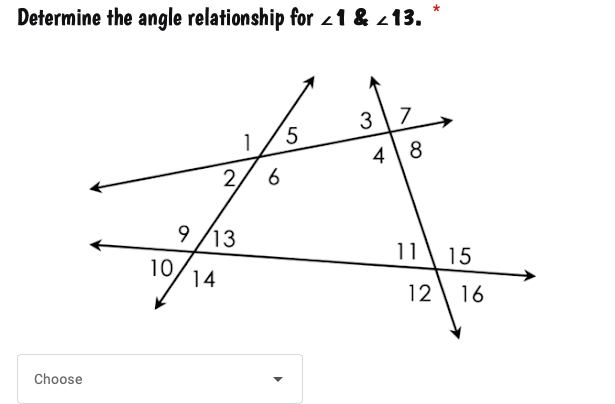Determine the angle relationship for ∠1 & ∠13.

Understand the Problem
The question is asking to determine the relationship between angles 1 and 13 in a diagram involving intersecting lines. The user needs to analyze the angles formed by the lines to identify their relationship, such as whether they are corresponding angles, alternate interior angles, etc.
Answer
Angle 1 and angle 13 are consecutive interior angles.
Answer for screen readers
Angle 1 and angle 13 are consecutive interior angles.
Steps to Solve
- Identify the lines and angles involved
Examine the diagram to identify the two intersecting lines and the angles formed. Here, we have angle 1 and angle 13 located at the intersection of those lines.
- Determine the positions of angles 1 and 13
Angle 1 is located above the lower line to the left, while angle 13 is below that same line, but to the left of the intersecting lines.
- Classify the angle relationship
Check if angles 1 and 13 are on the same side of the transversal and their relation to each other. In this case, they are both on the same side of the transversal and are not alternate angles or corresponding angles.
- Identify the type of angle relationship
Since angles 1 and 13 are vertical angles, they are equal. However, they are not vertical angles; rather, they are consecutive interior angles.
- Conclusion on the angle relationship
Since angle 1 and angle 13 are on the same side of the transversal, they are classified as consecutive interior angles.
Angle 1 and angle 13 are consecutive interior angles.
More Information
Consecutive interior angles are interior angles that lie on the same side of the transversal. When two parallel lines are cut by a transversal, consecutive interior angles are supplementary, meaning they add up to 180 degrees. In this case, since they do not add up to 180, they are simply consecutive interior angles without further qualifications.
Tips
- Confusing consecutive interior angles with corresponding angles. Ensure to check their positions relative to the transversal.
- Misidentifying the angles as alternate interior angles; make sure to visually note their locations on the diagram.
AI-generated content may contain errors. Please verify critical information